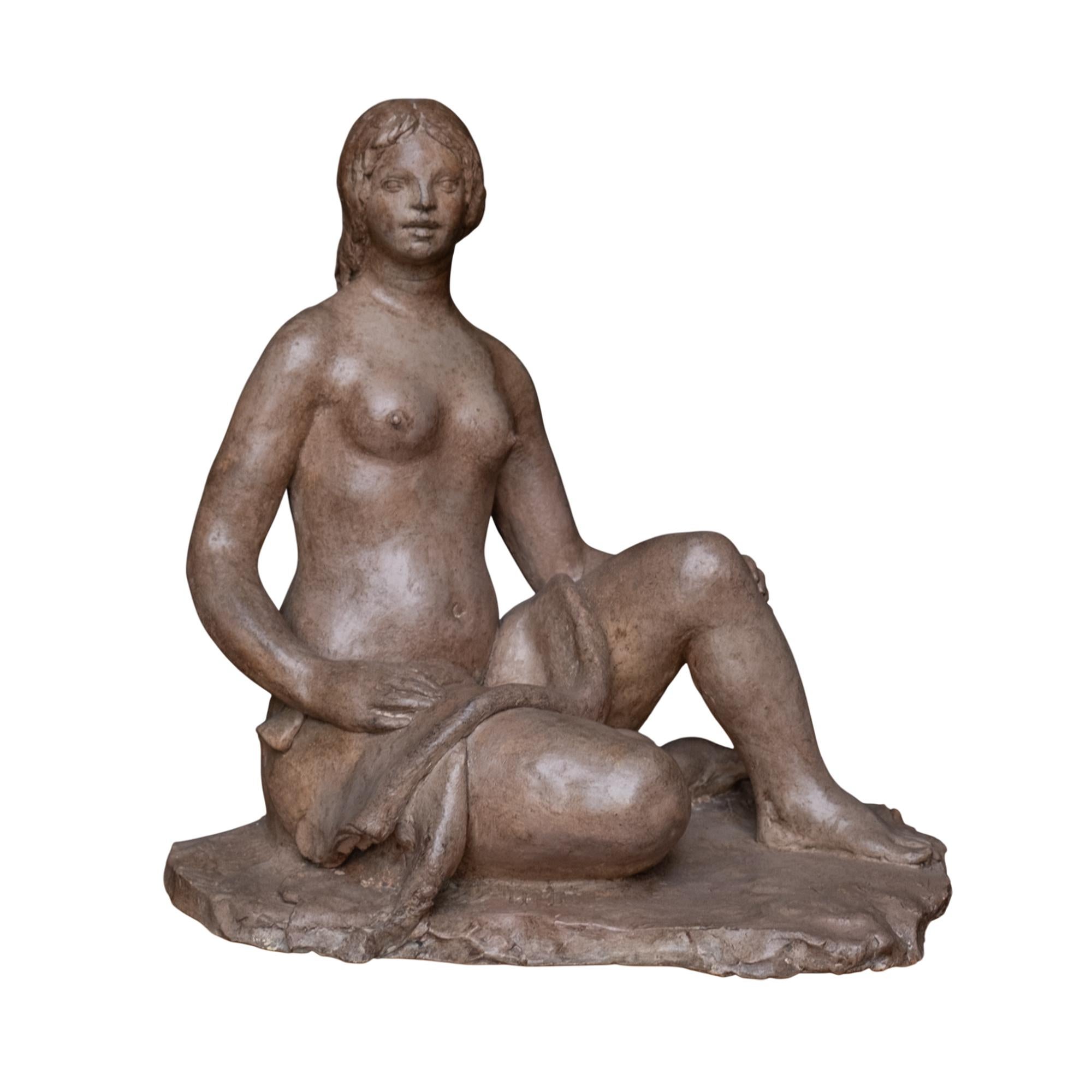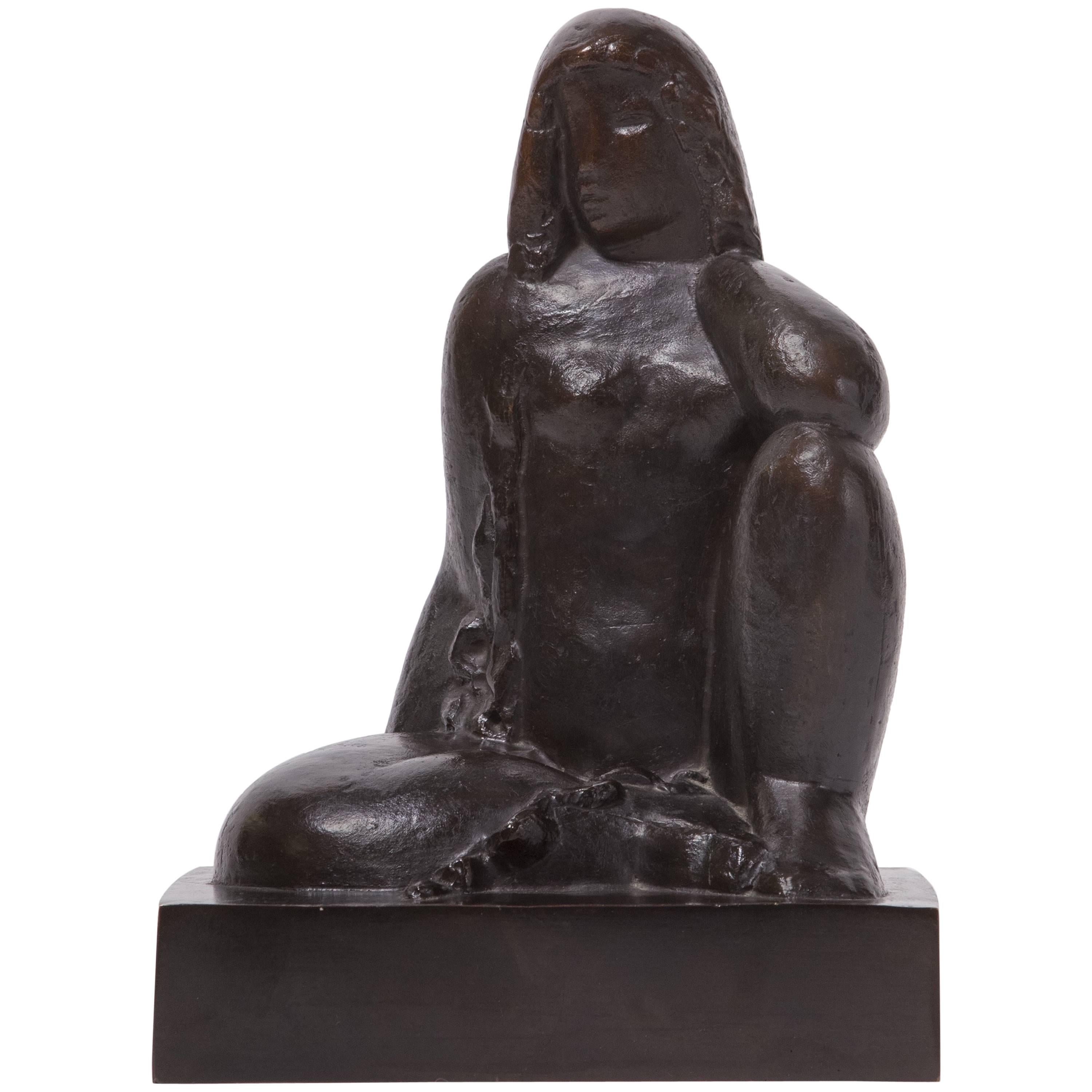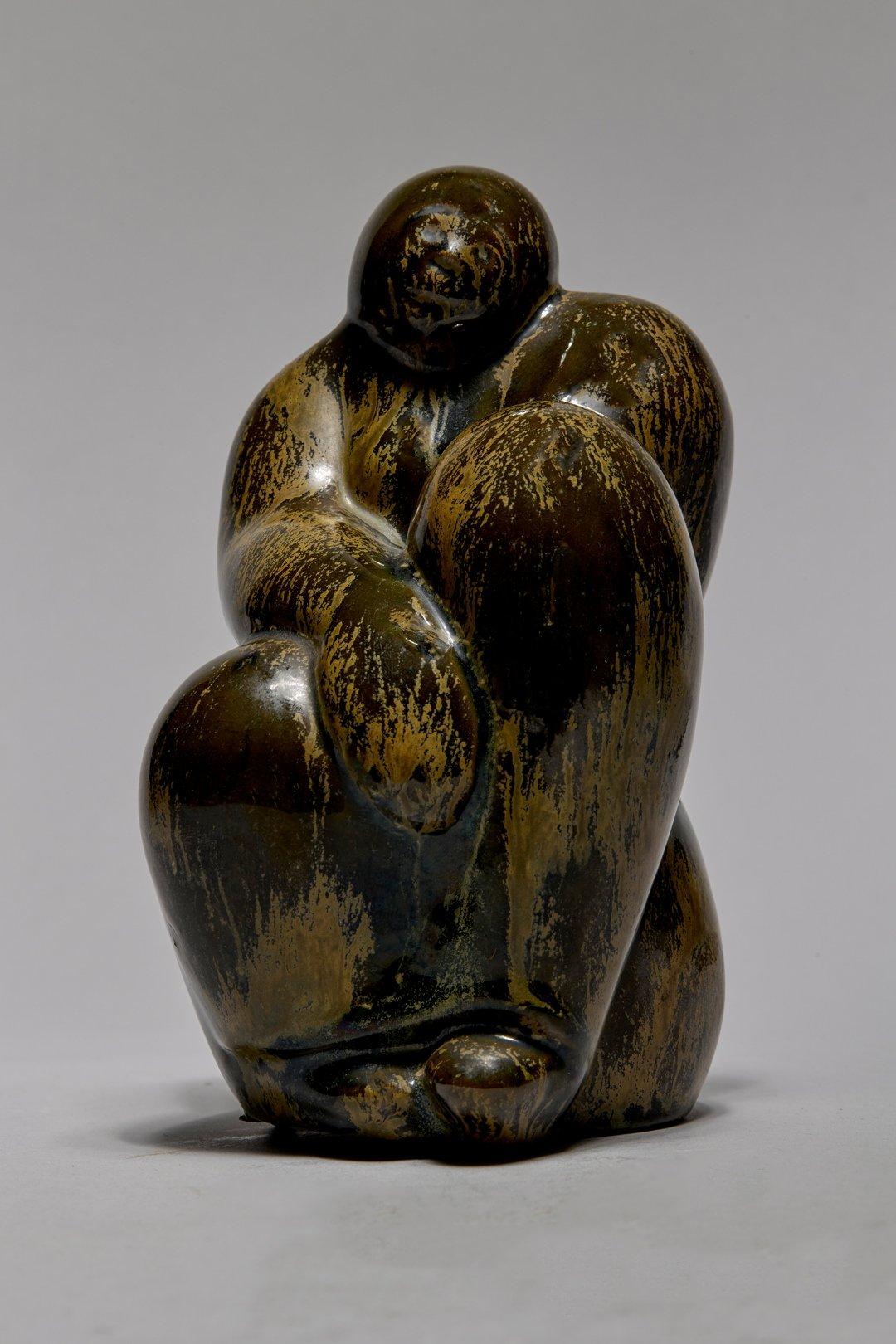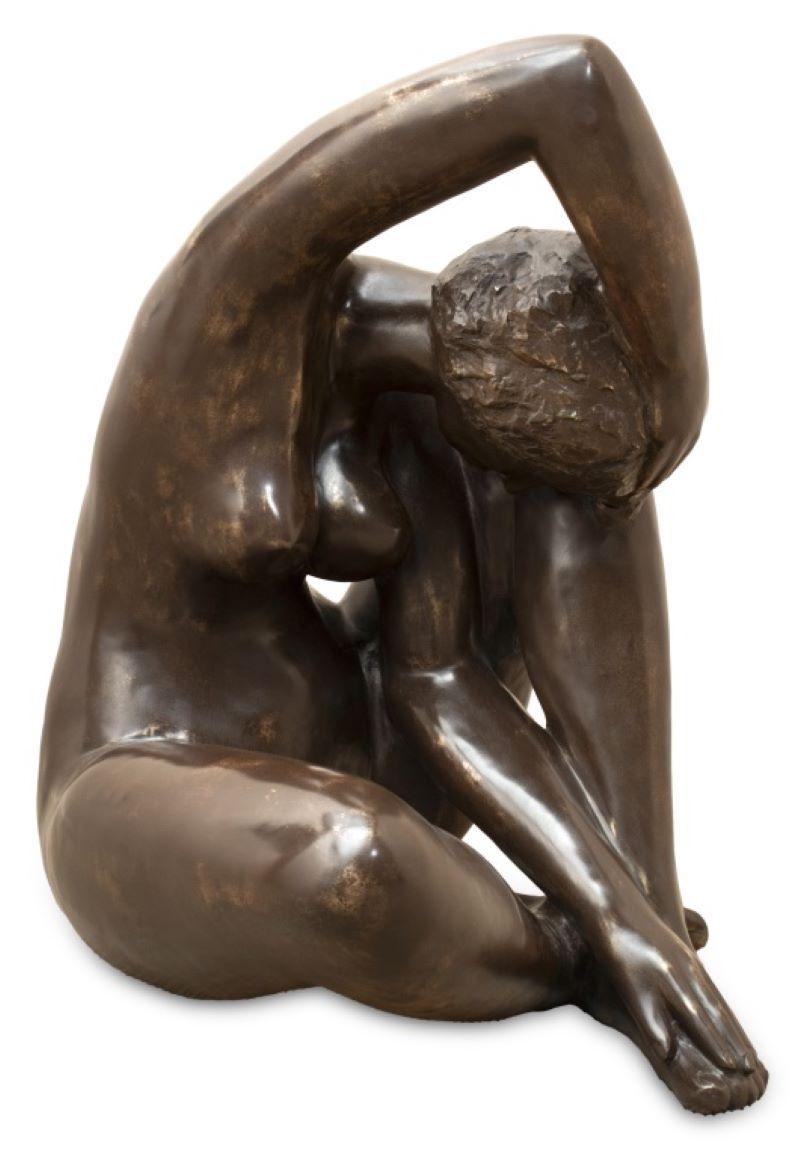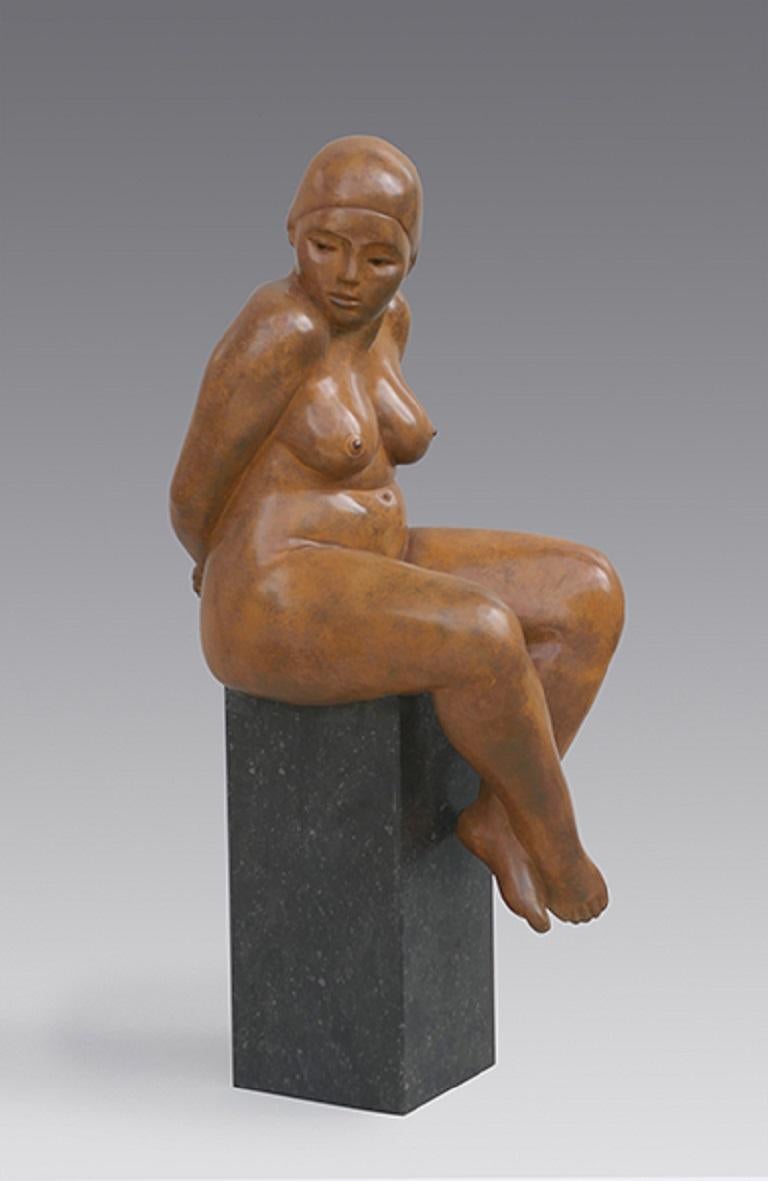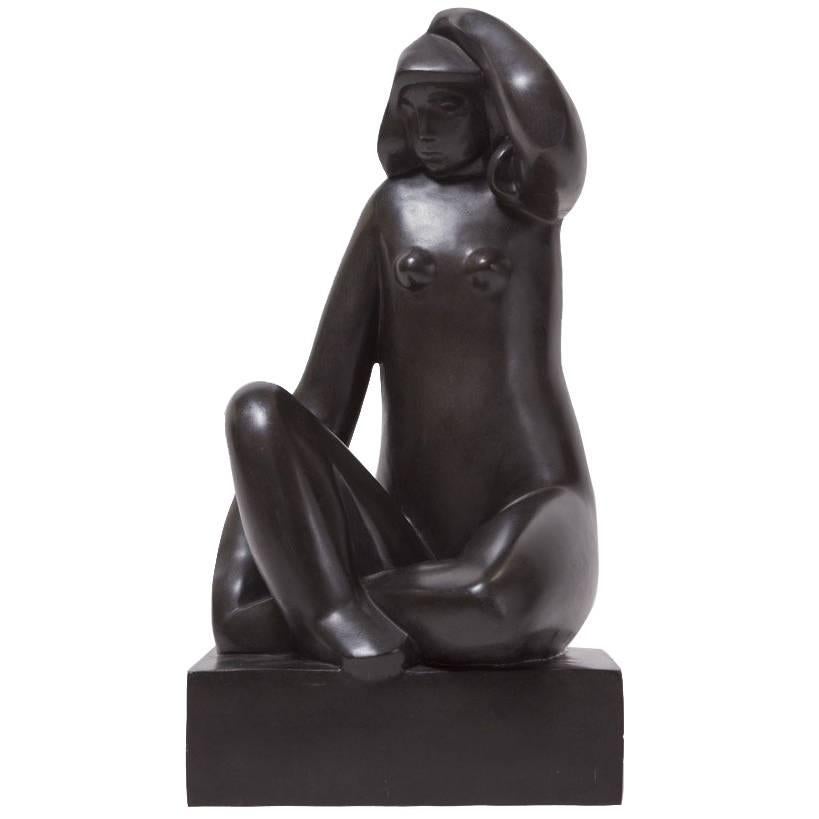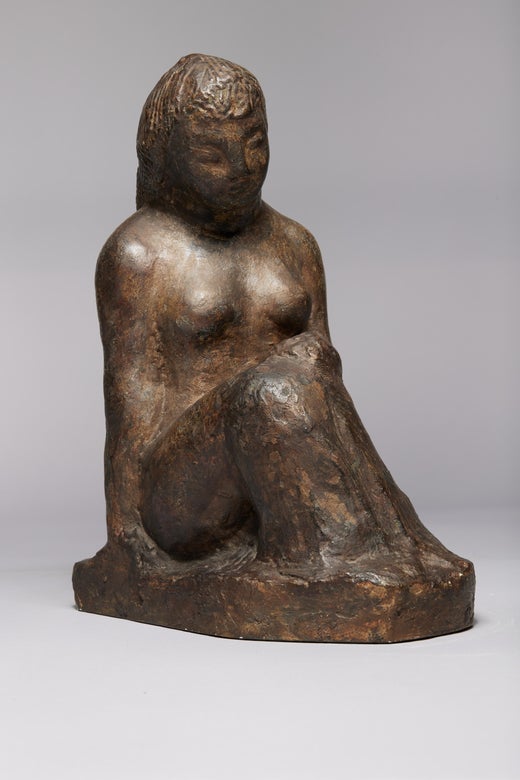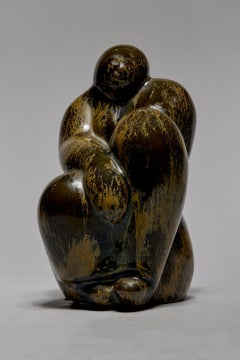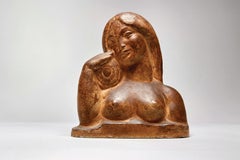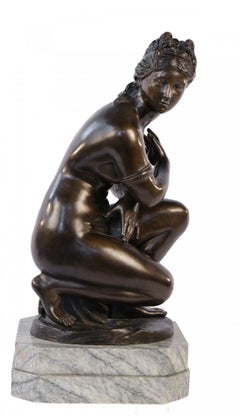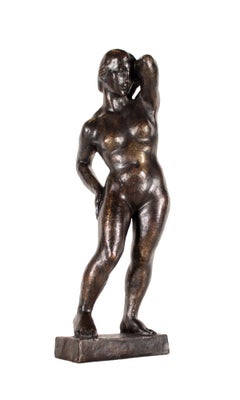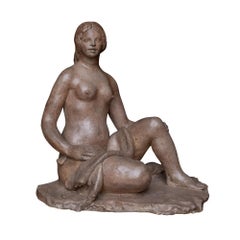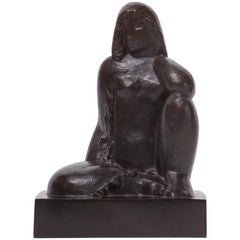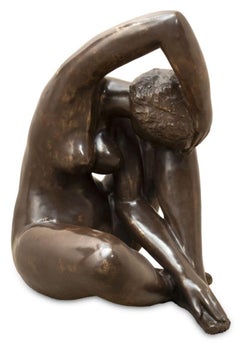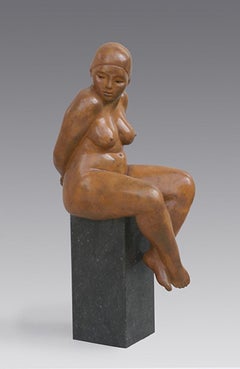Items Similar to Seated Nude Woman Sculpture, Early 20th Century
Video Loading
Want more images or videos?
Request additional images or videos from the seller
1 of 13
William ZorachSeated Nude Woman Sculpture, Early 20th Century
$6,000
£4,555.94
€5,210.06
CA$8,382.87
A$9,323.58
CHF 4,868.48
MX$113,458.07
NOK 62,177.98
SEK 58,311.97
DKK 38,884.67
Shipping
Retrieving quote...The 1stDibs Promise:
Authenticity Guarantee,
Money-Back Guarantee,
24-Hour Cancellation
About the Item
William Zorach (American, 1887-1966)
Seated Woman
Painted plaster
Inscribed underside "V"
12.5 x 9 x 5 inches
Provenance: The Tatti Family Collection
Bill Zorach was born in Lithuania in 1887, emigrated to the United States when he was four not knowing a word of English, grew up in poverty, and left school in seventh grade. He then worked unsuccessfully in a variety of low-paid, entry-level jobs. Finally apprenticing as a lithographer, he saved whatever he could, and paid his own way to art school, first in his hometown of Cleveland, then New York, and finally Paris. It was in Paris where he met Marguerite Zorach; she persuaded him of the merits of the startling new trends in art. He was successful in Paris from the beginning; he had four pictures accepted and two “hung in the line” at the juried, avant-garde Salon d’Automne. His paintings scandalized critics when he participated in the seminal Armory Show of 1913, the notorious show that introduced modernism to America. He also participated in a famous and much more selective exhibition, The Forum Exhibition of Modern American Painters in 1916.
He had a calling not just to be an artist but discovered, not long into his career, his specific calling to be a sculptor; he taught himself the principles and methods of sculpture. He soon abandoned oil painting but continued to paint with watercolors, which he loved; his watercolors are meditations and odes to the constantly changing world around him, its moods, light, colors, character, and specific features. While these two media differ dramatically from one another, Bill conveyed a shared message when he worked in them. As a sculptor along with a few others, he pioneered the art of direct carving, and was unique in often using very hard, colored, and patterned stones like granite boulders, which he often found himself on walks. His work was inspired by the stones he used and is more expressive (especially of love, strength, and inner peace), spontaneous, and simplified than that of his predecessors. There is also a spirituality to them. Bill was very thoughtful and articulate about his work. He can be mistaken as a conservative or representational sculptor only by those unfamiliar with his immediate predecessors. Critics, collectors, and the public greatly admired Bill because he treated subjects of longstanding importance and affection to humanity with freshness, dignity, and restraint while emphasizing sculptural values. He was among the best known and respected sculptors of his generation, wrote a text about sculpture that is still used today, and was also beloved as a teacher.
He died in Maine in 1966.
- Creator:William Zorach (1887 - 1966, American)
- Dimensions:Height: 12.5 in (31.75 cm)Width: 9 in (22.86 cm)Depth: 5 in (12.7 cm)
- Medium:
- Period:
- Condition:
- Gallery Location:Beachwood, OH
- Reference Number:1stDibs: LU1768216477142
William Zorach
Born in 1887, by 1930, he was one of America’s premier 20th century sculptors and was honored with multiple commissions and exhibitions including at the Art Institute of Chicago, the Dallas Museum of Fine Art, the Whitney Museum of American Art, and numerous others. He studied in New York City at the National Academy of Design and also in Paris under the mentoring of Jacques-Emile Blanche. It was in Paris in the first decade of the 20th century where Zorach’s path crossed with Marguerite, his soon to be wife. Both Marguerite and William were both represented in the landmark Armory Show of 1913. William continued to paint for the next two decades, but increasingly experimenting with sculpture. By the mid 20’s he was carving significant works in marble and stone. By the early 30’s, he abandoned painting entirely in favor of a new art form, sculpture. I t was in sculpture that Zorach found his true voice as an artist and achieved considerable success. “Sculpture, direct carving, was an expanding universe, a liberation and a natural form of expression to me.” Zorach stated. Museum Collections: Amon Carter Museum of American Art
Arizona State University Art Museum
Boca Raton Museum of Art
Butler Institute of American Art
Cleveland Artists Foundation
Colorado Springs Fine Arts Center
Cornish Colony Museum
Dallas Museum of Art
Delaware Art Museum
Edwin a Ulrich Museum of Art
Farnsworth Art Museum
Flint Institute of Arts
Frederick R Weisman Art Museum
Georgia Museum of Art
Herbert F Johnson Museum of Art
Jack S Blanton Museum of Art
LaSalle University Art Museum
Los Angeles County Museum of Art
Lowe Art Museum
Marion Koogler McNay Art Museum
Memorial Art Gallery
Metropolitan Museum of Art, NYC
Middlebury College Museum of Art
Minneapolis Institute of Arts
Mobile Museum of Art
Museum of Fine Art-Boston
Pennsylvania Academy of the Fine Arts
Portland Museum of Art
Smithsonian Museum of Art
The Brooklyn Museum of Art
The Canton Museum of Art
The Columbus Museum of Art-Ohio
The Columbus Museum-Georgia
The Cummer Museum Of Art & Gardens
The Currier Museum of Art
The Nelson-Atkins Museum of Art
The Newark Museum
The Phillips Collection
The Phillips Museum of Art
The University of Michigan Museum of Art
Whitney Museum of American Art
Worcester Art Museum
Yosemite Museum
About the Seller
5.0
Vetted Professional Seller
Every seller passes strict standards for authenticity and reliability
Established in 1975
1stDibs seller since 2022
34 sales on 1stDibs
Typical response time: 1 hour
- ShippingRetrieving quote...Shipping from: Beachwood, OH
- Return Policy
Authenticity Guarantee
In the unlikely event there’s an issue with an item’s authenticity, contact us within 1 year for a full refund. DetailsMoney-Back Guarantee
If your item is not as described, is damaged in transit, or does not arrive, contact us within 7 days for a full refund. Details24-Hour Cancellation
You have a 24-hour grace period in which to reconsider your purchase, with no questions asked.Vetted Professional Sellers
Our world-class sellers must adhere to strict standards for service and quality, maintaining the integrity of our listings.Price-Match Guarantee
If you find that a seller listed the same item for a lower price elsewhere, we’ll match it.Trusted Global Delivery
Our best-in-class carrier network provides specialized shipping options worldwide, including custom delivery.More From This Seller
View AllMid-Century Ceramic Sculpture of a Seated Female, Cleveland School Artist
Located in Beachwood, OH
Walter Sinz (American, 1881-1966)
Seated Female, c. 1940
Ceramic
6 x 3.5 x 3.5 inches
Walter A. Sinz was an American sculptor born in Cleveland, Ohio on July 13, 1881. Sinz’s fathe...
Category
1940s Figurative Sculptures
Materials
Ceramic
Zinnia, early 20th century sculpture of nude bust of woman, Cleveland School
Located in Beachwood, OH
Walter Sinz (American, 1881-1966)
Zinnia, c. 1930
Plaster
Signed on base
9 x 8 x 4 inches
Walter A. Sinz was an American sculptor born in Cleveland, Ohio on July 13, 1881. Sinz’s fa...
Category
1930s Figurative Sculptures
Materials
Plaster
Figure of Crouching Venus/Naked Aphrodite, 19th Century Italian School Sculpture
Located in Beachwood, OH
Bronze Figure of Crouching Venus, or The Naked Aphrodite, 19th Century Italian School
Bronze raised on a marble base
21 in. h. x 10 in. w. x 7 in. d., overall
18 in. h. x 8.5 in. w....
Category
19th Century Figurative Sculptures
Materials
Marble, Bronze
Italian Bronze Sculpture of Nude Woman, Mid 20th Century
Located in Beachwood, OH
Mario Spampinato (Italian 1912–2000)
Nude
Bronze
Signed on base
17.5 in. h. x 5.75 in. w. x 6 in. d.
The artist was born, raised and trained in Italy. During one of his exhibits (at San Marcos in Rome) the Director of a New York Gallery asked him to come to New York to work for him. The American Consul, before issuing his visa, asked Spampinato to create a bust of him. In exchange, the Consul paid for his passage on the boat to New York. In New York, he worked with his brother Clemente Spampinato who is a well known sculptor as well.
After moving to Chicago in 1954, he discovered that there was no foundry in the Midwest that could cast his bronzes. So, he opened his own foundry called the Spampinato Art Foundry, casting in the lost wax process. He also started his own private school (Spampinato Art Workshop, Ltd) and did some teaching at the University of Chicago and conducted seminars at Lawrence University in Kansas.
Many of his own works are pictured and cataloged in Volumes 2 & 3 of Bronzes: Sculptors and Founders, 1800-1930 by Harold Berman.
Between 1959 and 1967, Spampinato recast a number of Charles M Russell...
Category
Mid-20th Century Figurative Sculptures
Materials
Bronze
19th Century Bronze Figure of Crouching Venus or Naked Aphrodite
Located in Beachwood, OH
19th Century Bronze Figure of Crouching Venus or Naked Aphrodite
Bronze with dark patination
22.5 x 13 x 11 inches
The Crouching Venus is a Hellenisti...
Category
19th Century Figurative Sculptures
Materials
Bronze
First Steps, Early 20th Century Bronze Sculpture, Cleveland School
By William Zorach
Located in Beachwood, OH
William Zorach (American 1891-1966)
First Steps, 1918
Bronze
8.5 x 5 x 4 inches, including base
Born in 1887 in Lithuania, William Zorach immigrated with his family to the United States when he was just four years old, settling in Cleveland, Ohio. Zorach displayed an exceptional artistic talent at a young age and, at the recommendation of his seventh-grade teacher, began studying lithography at night at the Cleveland School of Art. It was not long before he was apprenticing at a lithography company in Cleveland. It was there that he realized he wanted to become an artist - to escape the commercial end of the field in which he was suddenly immersed.
In 1907, Zorach saved enough money to move to New York and study art at the National Academy of Design, where he received several awards for his paintings and drawings. He continued his studies in Paris in 1910 at La Palette. This year abroad would turn out to be quite fruitful because in Paris he was greatly influenced by the Cubist and Fauvist movements and had several paintings exhibited at the Salon d'Automme. This influence and subsequent success fueled his career back in the states where he was honored with his first one-man exhibition. Due to this new-found stability, he married a young woman he met at school in Paris, and they moved to New York and set up a studio. Shortly after, their work was accepted into the famous 1913 Armory Show.
For the next nine years, Zorach continued to think of himself as a painter, although he had already begun to experiment in sculpting. He was experiencing modest success with his painting and was therefore reluctant to abandon it completely. However, he was impelled toward sculpting, and in 1922, he painted his last oil.
Zorach's involvement with sculpture began largely be accident. While he was working on a series of wood-block prints, Zorach suddenly became more interested in the butternut panel than the print and turned the panel into a carved relief. With no formal training as a sculptor, Zorach's first sculptures were of wood and his carving tools were primitive, such as a jack-knife. I n fact, his early works have a certain stylized look, suggesting the influence of various primitive arts such as African and American folk.
Zorach found his sculptural direction by instinct, but was not unaware of what other sculptors were doing, both here and abroad. He soon allied himself with a growing number of modern sculptors who believed in the esthetic necessity of carving their own designs directly in the block of stone or wood rather than modeling them in clay. From the beginning he found a deep satisfaction in the slow and patient process of freeing the image from its imprisoning block, watching the forms emerge and appear.
"The actual resistance of tough material is a wonderful guide," Zorach said in a lecture on direct sculpture in 1930. The sculptor "cannot make changes easily, there is no putting back tomorrow what was cut away today. His senses are constantly alert. If something goes wrong there is the struggle to right the rhythm. And slowly the vision grows as the work progresses." Zorach also found that the material itself had a constantly modifying effect on the artist's vision. The grain of the wood, the markings in the stone, the shape of the log or boulder all set limits and suggested possibilities. He was always sensitive to the characteristic qualities of his material and occasionally let them play a major role in determining his forms. In works such as these, the feel of the original material is preserved in the finished piece and is often heightened by leaving parts of the original surface untouched and other areas roughly marked by the sculptors tools...
Category
1910s Figurative Sculptures
Materials
Bronze
You May Also Like
Seated Female Nude, circa 1930-1940, Giorgio Rossi (1894–1981), Tuscan sculptor
Located in Firenze, IT
Seated Female Nude, circa 1930-1940, Giorgio Rossi (1894–1981), Tuscan sculptor
Period: circa 1930-1940
Artist: Giorgio Rossi (1894–1981)
This sculptu...
Category
1930s Nude Sculptures
Materials
Clay, Terracotta
Sculpture 'Nude Sitting' by Joseph Csaky, 1929
By Joseph Csaky
Located in Paris, FR
Sculpture in bronze with black patina
Signed and numbered 8/8. Stamped with the foundry stamp Blanchet and marked AC (Atelier Csaky)
The model from 1929, the present cast is a Post...
Category
Vintage 1920s French Art Deco Figurative Sculptures
Materials
Bronze
Jean Laniau Seated Nude Woman Patinated Bronze
Located in Astoria, NY
Jean Laniau (French, b. 1931) Seated Nude Woman Patinated Bronze Sculpture, depicting a female figure wrapping arms over head and through her legs, signed and marked edition "4/8" to...
Category
Late 20th Century Nude Sculptures
Materials
Bronze
Venus Bronze Sculpture Woman Contemporary Female Nude Sitting Lady
By Erwin Meijer
Located in Utrecht, NL
Venus Bronze Sculpture Woman Contemporary Female Nude Sitting Lady
The statues of Erwin Meijer are subtle with a recognizable, personal handwriting.
They ...
Category
21st Century and Contemporary Contemporary Figurative Sculptures
Materials
Bronze
$4,676 Sale Price
20% Off
Free Shipping
Bronze Sculpture "Woman Sitting Hand on Her Head" by Joseph Csaky, 1932
By Joseph Csaky
Located in Paris, FR
Sculpture in bronze with black patina
Signed and numbered. Stamped with the foundry stamp Blanchet and marked AC (Atelier Csaky)
The model from 1932, the present cast is a postmort...
Category
Vintage 1930s French Art Deco Figurative Sculptures
Materials
Bronze
Nude Seated Woman Terracotta, by Dry Morin 1940-1950 France
By Morin Dry
Located in Beuzevillette, FR
Beautiful representation of a nude woman seated, terra cotta by Morin Dry.
Art Deco
Signed on the base,
1940s.
Category
Mid-20th Century European Art Deco Figurative Sculptures
Materials
Terracotta
$1,498 Sale Price
21% Off
More Ways To Browse
Antique Sculpture
Antique Sculptures
Meditation Sculpture
Plaster Woman Sculpture
Antique Forum
V Trend
Brooklyn Bridge Warhol
Carlos Barrios
Cherry Pond
Circus Carving
Coronel Rafael
Dallas Prince
Devon Railway
Emil Ceramic
Etchings Lake George
German Olympic Poster 1936
Helen Frankenthaler Lincoln Center Posters
Hilda Brown
